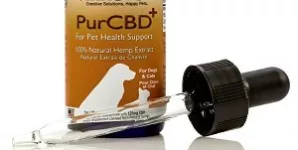There is a new health supplement out there that a growing number of pet owners are giving their pets to treat several medical conditions. It’s called cannabidiol oil, but I’m sure you know it better as CBD oil.
“Wait, canna-what! Did you just say people are giving their pets cannabis?” You are correct! More and more pet owners are giving their pets cannabis, and it has been helping in ways we never thought it could. However, if you asked if people were giving their pets marijuana, I would have said no. Confused yet?
Explaining Cannabis: Is CBD Marijuana?
It’s understandable why there is confusion over CBD oil and what it is. Cannabis has long been misunderstood, and its terminology is no different. You can easily see this when you look at the United States’ Control Substance Act, where marijuana is spelled as “marihuana” (because the Spanish language is totally difficult you guys).
Cannabis is the genus for two main varieties of plants: hemp and marijuana. Hemp is technically varieties of the Cannabis sativa L. plant and hails from Europe where it stalks and seeds were originally used for fiber and materials. Marijuana comes from Cannabis indica and originally hails from India where it stalks and seeds were used for material as well, but its flowers were also used to produced hashish.
If you know a little about marijuana, you’ve most likely heard talk about indica and sativa strains, but they both come from Cannabis indica despite Cannabis sativa existing. Again, our terminology is super messy.
Cannabidiol (CBD) is found in high quantities in all cannabis plants, but tetrahydrocannabinol (THC), or the psychoactive chemical that causes a high, is only found in high amounts in Cannabis indica strains.
It’s confusing I know so . . .
Long story short: Cannabidiol(CBD is found) in all cannabis plants. Both hemp and marijuana plants come from the genus Cannabis. Hemp has no THC unlike marijuana, and as such, it can’t get you high. Therefore, you should always get your CBD oil from hemp ensuring you never get your cat high unless it’s with catnip—that’s completely fine.
Another benefit that comes with CBD derived from hemp is that it’s legal in the entire United States. You can easily find it online and have it shipped to your house.
How CBD Works
So what are CBD and THC? Well, they’re phytocannabinoids that look and act like endocannabinoids. Mammals including you, me, and our cats all produce our own endocannabinoids. Both plants and animals produce cannabinoids, so don’t let the prefix “canna” fool you into thinking you can only find them in cannabis. So what’s their purpose?
The brain creates these endocannabinoids to act as neurotransmitters which it sends off to different receptors sites located throughout every part of the body—these receptors are found in all internal systems and organs. What’s the point of all this?
That would be homeostasis. Homeostasis is an organism’s ability to repair itself on its own. We often only associate our body’s defense system with fighting germs but it does so much more. For example, how do you think your internal temperature stays around 98 degrees fahrenheit regardless if it’s cold or hot outside? If you guessed homeostasis, you guessed right.
You’re not aware of it, but your natural defense systems are in a constant battle with an insane amount of threats: germs, stress, fear, temperature fluctuations, pathogens, carcinogens, etc. Most of the time these defenses can handle the job on their own, but since both us and our pets get sick this isn’t always the case.
That’s where phytocannabinoids, especially CBD, come into the equation. CBD will do one of two things. First, it prevents endocannabinoids from being prematurely broken down and recycled. This allows them to build up in the body and attach to more receptors resulting in better health across the board. When a mammal’s body can’t produce enough endocannabinoids, CBD and other phytocannabinoids in CBD oil will attach to the same receptors and do the endocannabinoids job for them without causing harm.
THC is the oddball
THC is the only phytocannabinoid that can attach to CB1 receptors which occur in highly concentrated amounts in the brain. This indirect attachment to CB1 receptors produces a high and makes THC unsafe for certain pets and children with developing brains. Dogs, in particular, appear to have a higher than normal amount of CB1 receptors in their hindbrains. This produces a much stronger and dangerous high compared to humans. This is a perfect segway into our next topic.
Safety: What Side Effects Can I Expect?
With hemp derived CBD, you can expect mostly mild and rare side effects: nausea, tiredness, and dry mouth.
The one area of concern is CBD’s interaction with CYP liver enzymes. CBD likes attaching to enzymes—its attachment to FAAH enzymes is what stops endocannabinoids from being prematurely broken down.
But the CYP enzymes CBD deactivates are responsible for metabolizing the majority of pharmaceuticals drugs on the market. This means in theory, CBD can indirectly raise drug concentration levels in blood plasma. This subject is still being thoroughly looked into, but when most studies show this rare interaction, they conclude that use of CBD should continue and plasma levels monitored.
Even when CBD raises drug concentrations, continued use often allows the patient to lower the overall dosage of their prescription drug. This is great news since CBD has a much lower side effect profile compared to them.
Dosage: How Much Do I Give Them?
Now that we know CBD oil derived from hemp is safe to give, let’s figure out how much to give. You’ll want to get a rough estimate of your cat’s weight—don’t worry if you’re off by a few pounds.
- Low – 0.22mg/lb or .05/kg
- Average – 0.068mg/lb or 0.15mg/kg
- High – 0.136mg/lb or 0.30/kg
Start off with a low dose once a day for about a week and monitor how your cat handles it. After a week, if you feel the need to move up to an average dose, you can. As well, you can increase the dose to twice a day before moving into the high dosage range. There is little worry that comes from a high dose compared to a low dose if your cat is not on any medication that’s metabolized in the liver. If they are, make sure you’re talking and working with your veterinarian before moving up to an above average dose.
Best Way to Give CBD
CBD comes in a lot of different forms from oils, nasal sprays, edibles, etc. For, cats the oil form is the best for several reasons. CBD oil allows you to make small incremental changes in dosage and this is great for finding the right dose for your cat.
For cats, most owners find the easiest way to administer CBD is by rubbing it onto their gums. This comes with its own benefits, such as a faster absorption rate for faster relief and it potentially avoids metabolization in the liver avoiding CYP enzymes.
Knowing Which is the Right CBD
Before I leave you, here some helpful rules to follow for choosing the right CBD oil for cat.
- Make sure it’s derived from phytocannabinoid hemp so it’s legal and has 0.03 THC or less.
- Look for the term full spectrum hemp, CBD, or phytocannabinoids (PCR)
- Make sure the company provides a certificate of analysis (COA) or lab report.
- Always check for customer reviews!!








